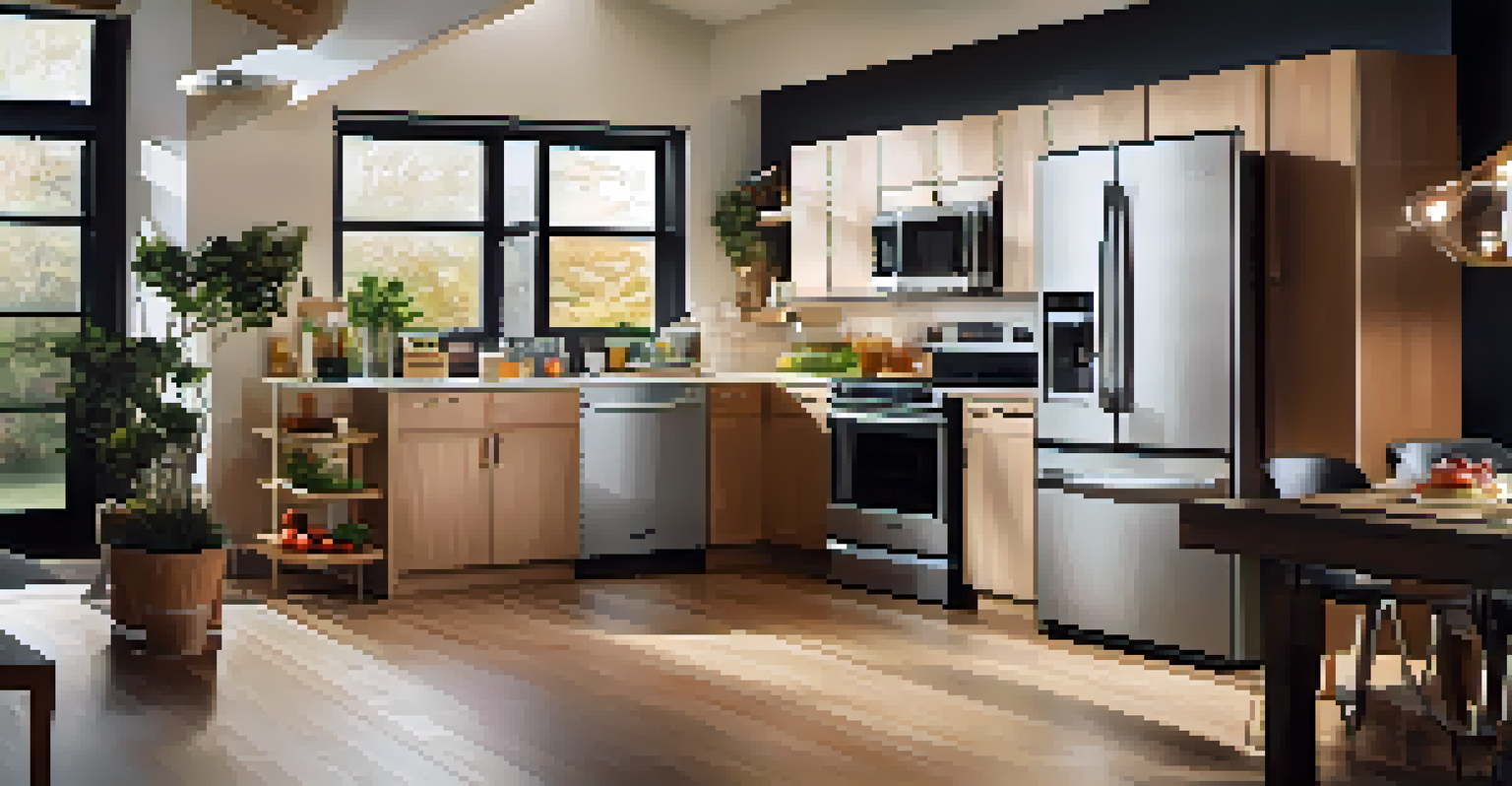How Smart Home Automation Can Lower Your Utility Bills

Understanding Smart Home Automation Basics
Smart home automation refers to the use of technology to control home systems and appliances from a centralized device, often through your smartphone or voice commands. This can include everything from lighting and heating to security systems and appliances. Imagine being able to adjust your thermostat from the couch or turn off lights that you left on while rushing out the door.
The future is already here — it’s just not very evenly distributed.
The beauty of smart home technology lies in its ability to streamline daily tasks and enhance energy efficiency. By automating these systems, homeowners can ensure they are used only when needed, reducing unnecessary energy consumption. For instance, smart thermostats learn your schedule and adjust heating and cooling automatically, ensuring comfort while avoiding energy waste.
Ultimately, understanding these basic concepts can help you appreciate the potential savings smart home automation brings. It's not just about convenience; it's about making informed choices that lead to lower utility bills.
Smart Thermostats: A Game Changer for Energy Savings
One of the standout features of smart home automation is the smart thermostat. Unlike traditional models, smart thermostats can learn your habits and adjust the temperature accordingly, helping you save on heating and cooling costs. For example, if you typically lower the temperature during the day when no one is home, a smart thermostat will remember this and do it automatically.

Many smart thermostats also offer remote access via mobile apps, enabling you to adjust settings from anywhere. Imagine coming home from work on a hot day and finding your house comfortable because you adjusted the thermostat while on the way home. This not only saves energy but also enhances your comfort.
Smart Thermostats Save Energy
Smart thermostats learn your habits to automatically adjust temperatures, resulting in significant energy savings.
Incorporating a smart thermostat can lead to significant savings on your utility bills, often paying for itself within a year or two. With reduced energy usage, your bills will reflect the positive impact of this smart investment.
Smart Lighting: Bright Ideas for Lower Bills
Smart lighting systems allow you to control your home’s lighting effortlessly, which can lead to notable energy savings. By using LED smart bulbs that consume less power, coupled with features like dimming and scheduling, you can significantly reduce electricity use. Picture a home where lights automatically turn off when you leave a room—this is the future of energy-efficient living.
Technology, like art, is a soaring exercise of the human imagination.
Additionally, smart lighting can be programmed to mimic your presence at home, which can deter potential intruders while ensuring you’re not wasting energy on lights left on throughout the day. This added layer of security is just one of the many benefits that come with smart lighting.
By making the switch to smart lighting, you can enjoy both convenience and cost savings. With various options available, it’s easier than ever to create a customized lighting plan that works for your lifestyle and budget.
Energy Monitoring: Know Where Your Money Goes
Energy monitoring systems are essential in understanding your home's energy consumption. These systems can track which appliances use the most energy, giving you insights into where you can cut back. Imagine being able to see exactly how much energy your refrigerator or washing machine consumes each month—this data empowers you to make smarter choices.
With real-time monitoring, you can identify energy hogs and adjust usage accordingly. For example, if you notice that your washing machine uses a lot of energy during peak hours, you can shift your laundry schedule to off-peak times, saving on energy costs.
Smart Lighting for Efficiency
Smart lighting systems allow for automated control and energy-efficient usage, leading to lower electricity bills.
Utilizing energy monitoring technology not only helps you lower your utility bills but also fosters a more energy-conscious mindset. The more you know about your consumption patterns, the better equipped you are to make changes that benefit both your wallet and the environment.
Smart Appliances: Efficiency Meets Convenience
Smart appliances, like refrigerators, ovens, and dishwashers, are designed to optimize energy use without sacrificing performance. They often come with features that allow them to run during off-peak energy hours, which can lead to lower utility costs. Imagine a washing machine that can automatically schedule its wash cycle during the night when electricity rates are lower.
Moreover, many smart appliances have energy-saving modes that reduce power consumption while still getting the job done. For instance, a smart oven can adjust cooking times and temperatures to maximize efficiency, ensuring your meals are not only delicious but also cost-effective.
Investing in smart appliances can transform your home into an energy-efficient powerhouse, ultimately resulting in lower utility bills. This blend of technology and practicality makes them an appealing choice for budget-conscious homeowners.
Enhanced Home Security: Protecting Your Wallet
Smart home security systems not only keep your home safe but can also help you save on utility bills. Many modern security devices can detect when doors and windows are left open, alerting you to potential energy loss. For example, if you forget to close a window during your heating cycle, a smart sensor will notify you, allowing you to take corrective action.
Additionally, security cameras and motion sensors can help you monitor energy usage by ensuring that lights and appliances are turned off when not in use. This way, you can avoid wasting energy on items that don’t need to be on, all while keeping your home secure.
Environmental Benefits of Automation
Adopting smart home automation reduces energy consumption and carbon emissions, contributing to a more sustainable future.
By integrating smart security features into your home, you're not just protecting your belongings; you're also creating an energy-efficient environment that can lead to lower utility costs.
The Environmental Benefits of Smart Home Automation
Smart home automation not only impacts your utility bills but also has a positive effect on the environment. By reducing energy consumption, you’re contributing to lower carbon emissions, which is crucial in the fight against climate change. Imagine the collective impact if every household adopted energy-efficient practices through smart technology.
Moreover, many smart devices are designed with sustainability in mind, allowing you to track and reduce your energy consumption over time. This awareness can lead to more conscious decisions about energy use, fostering a greener lifestyle.

By embracing smart home automation, you're not just enhancing your comfort and saving money—you're also playing a part in creating a more sustainable future. This dual benefit is what makes smart technology so appealing to modern homeowners.
Getting Started with Smart Home Automation
Starting your journey into smart home automation doesn't have to be overwhelming. Begin by identifying areas in your home where you can benefit the most from automation, such as lighting, heating, or security. Consider investing in a smart hub, which can connect various devices and streamline your home's automation system.
Next, take it step by step—start with one or two smart devices and gradually expand your system as you become more comfortable. For example, you might begin with a smart thermostat and a set of smart bulbs, then explore additional devices based on your needs and budget.
Remember, the key is to choose technologies that suit your lifestyle and priorities. As you embrace smart home automation, you’ll soon discover how it can lead to a more efficient, comfortable, and cost-effective home.